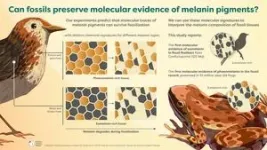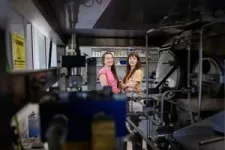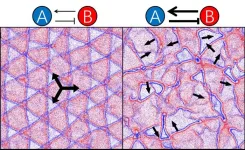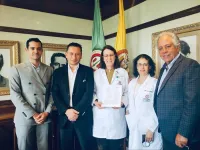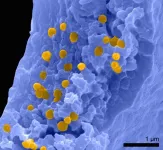(Press-News.org) Details of past climate conditions are revealed to researchers not only by sediment samples from the ocean floor, but also by the surface of the seafloor, which is exposed to currents that are constantly altering it. Deposits shaped by near-bottom currents are called contourites. These sediment deposits contain information about past ocean conditions as well as clues to climate. Contourites are often found on continental slopes or around deep-sea mountains. But they can be found in any environment where strong currents occur near the seafloor. The mechanisms that control them are not yet well understood. Experiments in flume tanks will help to change this through the depiction of deposition in future models.
Detailed observations of changes in flume-tank experiments
Henriette Wilckens, first author of the newly published study, created a replica of the continental slope in a special flume tank at the University of Utrecht (Netherlands). Currents and sediment input in the flume tank were simulated using pumps and monitored with a current meter. The formation and development of the sediment deposits were measured with a laser scanner. All the data obtained were compared to measurements in natural ocean systems in order to validate the results of the experiments.
“The internal sediment architecture of contourites can be observed from seismic data, but in order to unlock information about the past ocean currents we need a better understanding of how they developed and the factors that influence the contourite systems,” explains Wilckens. While it is impossible to directly see how natural marine systems that developed over time periods of thousands to millions of years started to form on the seafloor, scientists can employ flume-tank experiments to directly observe detailed changes of the seafloor morphology and control their related current velocities.
Huge application potential of the models
“Our experiment can also be applied to the entire deep sea and even to lakes,” says Henriette Wilckens, meaning anywhere in the deep sea where there is a slope, terraces, deep-sea mountains or, for example, cold-water coral mounds.
It is also conceivable that the models could be applied, for example, to improve predictions of how currents transport microplastic particles or other pollutants in the ocean. “The potential for its application,” says Wilckens, “is immense. The system must first be understood before it is possible to derive information from it.”
Opening a new branch of research
“This research work is an important step toward a better understanding of the ways in which ocean currents control the deposition of particles in the seafloor, which has important implications for paleoceanographic reconstructions and benthic ecology. This introduces a new branch of research that will probably lead to even more exciting discoveries,” according to Elda Miramontes, co-author of the study and head of the “Sedimentology” working group at MARUM.
END
Deciphering the intensity of past ocean currents
New publication: Researchers simulate past ocean conditions in flume-tank experiments
2023-10-06
ELSE PRESS RELEASES FROM THIS DATE:
How bacteria can organize themselves
2023-10-06
In a recent study, scientists from the department Living Matter Physics at MPI-DS developed a model describing communication pathways in bacterial populations. Bacteria show an overall organizational pattern by sensing the concentration of chemicals in their environment and adapting their motion.
The structure only becomes visible on a higher level
“We modeled the non-reciprocal interaction between two bacterial species”, first author Yu Duan explains. “This means that species A is chasing species B, whereas B is aiming to repel from A”, he continues. The researchers found, that just this chase-and-avoid interaction is sufficient to form a structural pattern. The ...
Pulsars may make dark matter glow
2023-10-06
The central question in the ongoing hunt for dark matter is: what is it made of? One possible answer is that dark matter consists of particles known as axions. A team of astrophysicists, led by researchers from the universities of Amsterdam and Princeton, has now shown that if dark matter consists of axions, it may reveal itself in the form of a subtle additional glow coming from pulsating stars.
Dark matter may be the most sought-for constituent of our universe. Surprisingly, this mysterious form of matter, ...
Researchers create a neural network for genomics—one that explains how it achieves accurate predictions
2023-10-06
A team of New York University computer scientists has created a neural network that can explain how it reaches its predictions. The work reveals what accounts for the functionality of neural networks—the engines that drive artificial intelligence and machine learning—thereby illuminating a process that has largely been concealed from users.
The breakthrough centers on a specific usage of neural networks that has become popular in recent years—tackling challenging biological questions. Among these are examinations of the intricacies of ...
Astronomers discover first step toward planet formation
2023-10-06
Astronomers have gotten very good at spotting the signs of planet formation around stars. But for a complete understanding of planet formation, we also need to study examples where planet formation has not yet started. Looking for something and not finding it can be even more difficult than finding it sometimes, but new detailed observations of the young star DG Taurus show that it has a smooth protoplanetary disk without signs of planet formation. This successful non-detection of planet formation may indicate ...
Faster growth of the placenta is linked to increased risk of preeclampsia
2023-10-06
Research sheds light on how genetics influences the growth of the placenta and reveals a link to increased risk of disease in the mother.
The placenta is an organ which grows in the womb alongside the foetus, which is attached to it by the umbilical cord. It is the only organ that contain tissue from both mother and child. The placenta provides oxygen and nutrients to the growing foetus and removes waste as the baby develops. A poorly functioning placenta is associated with pregnancy complications, and later risk of disease in the child.
Despite its key role, little is yet known ...
Integrated chronic care in Africa can improve outcomes and save money
2023-10-06
Across Africa about two million premature deaths each year are caused by the effects of diabetes and hypertension.
In contrast, most people living with HIV are in regular care and virally suppressed, and HIV mortality rates have fallen five-fold since their peak of 2 million deaths annually in the early 2000s to less than 500,000 in 2022.
Dr Josephine Birungi, a co-author and Graduate Researcher-Public Health at La Trobe University, said that the similarities in chronic disease management of HIV and other chronic conditions should make integrated clinics beneficial.
“The only difference is the medicine they take. We’re seeing ...
ObesityWeek® features hundreds of innovative scientific abstracts
2023-10-06
ROCKVILLE, Md.— Neary 240 scientific abstracts covering a variety of topics such as anti-obesity medications, body mass index and pediatric obesity will be featured at the 41st Annual Meeting of The Obesity Society’s (TOS) at ObesityWeek® 2023. This in-person event will take place Oct. 14–17, 2023 at the Kay Bailey Hutchison Convention Center in Dallas, Texas.
Innovative scientific research results will be presented in both oral and poster formats. These communications provide notable exposure and recognition for studies and authors, and represent cutting-edge research in obesity prevention and ...
Colombian National Cancer Institute signs MOU with BGI Genomics to combat cancer
2023-10-06
On October 2, 2023, BGI Genomics signed a Memorandum of Understanding (MoU) with the Colombian National Cancer Institute (INC or Instituto Nacional de Cancerologia). This collaboration, which aims to foster research and further develop cutting-edge solutions based on genetic sequencing for early diagnosis of cervical and colorectal cancer, reflects a shared dedication to enhancing health outcomes in the region.
The MoU was formally inked at INC facilities by Dr. Carolina Wiesner, INC Director, and Mr. Rainer Perez, alternate legal representative of BGI Genomics in Colombia. Mr. Marco Antonio Rincón, Latin America Business Director, BGI Genomics, notes: ...
Ginger pigment molecules found in fossil frogs
2023-10-06
UCC palaeontologists discover molecular evidence of phaeomelanin, the pigment that produces ginger colouration.
“This will paint a more accurate picture of ancient animal colour.”
Phaeomelanin is now toxic to animals – discovery may be first step in understand its evolution.
Palaeontologists at University College Cork (UCC) have found the first molecular evidence of phaeomelanin, the pigment that produces ginger colouration, in the fossil record.
The new study reports ...
Scientists discover ‘long colds’ may exist, as well as long Covid
2023-10-06
A new study from Queen Mary University of London, published in The Lancet’s EClinicalMedicine, has found that people may experience long-term symptoms —or ‘long colds’—after acute respiratory infections that test negative for COVID-19.
Some of the most common symptoms of the ‘long cold’ included coughing, stomach pain, and diarrhea more than 4 weeks after the initial infection. While the severity of an illness appears to be a key driver of risk of long-term symptoms, ...
LAST 30 PRESS RELEASES:
Scientists trace microplastics in fertilizer from fields to the beach
The Lancet Obstetrics, Gynecology, & Women’s Health: Taking paracetamol during pregnancy does not increase risk of autism, ADHD or intellectual disabilities, confirms new gold-standard evidence review
Taking paracetamol during pregnancy does not increase risk of autism, ADHD or intellectual disabilities
Harm reduction vending machines in New York State expand access to overdose treatment and drug test strips, UB studies confirm
University of Phoenix releases white paper on Credit for Prior Learning as a catalyst for internal mobility and retention
Canada losing track of salmon health as climate and industrial threats mount
Molecular sieve-confined Pt-FeOx catalysts achieve highly efficient reversible hydrogen cycle of methylcyclohexane-toluene
Investment in farm productivity tools key to reducing greenhouse gas
New review highlights electrochemical pathways to recover uranium from wastewater and seawater
Hidden pollutants in shale gas development raise environmental concerns, new review finds
Discarded cigarette butts transformed into high performance energy storage materials
Researchers highlight role of alternative RNA splicing in schizophrenia
NTU Singapore scientists find new way to disarm antibiotic-resistant bacteria and restore healing in chronic wounds
Research suggests nationwide racial bias in media reporting on gun violence
Revealing the cell’s nanocourier at work
Health impacts of nursing home staffing
Public views about opioid overdose and people with opioid use disorder
Age-related changes in sperm DNA may play a role in autism risk
Ambitious model fails to explain near-death experiences, experts say
Multifaceted effects of inward foreign direct investment on new venture creation
Exploring mutations that spontaneously switch on a key brain cell receptor
Two-step genome editing enables the creation of full-length humanized mouse models
Pusan National University researchers develop light-activated tissue adhesive patch for rapid, watertight neurosurgical sealing
Study finds so-called super agers tend to have at least two key genetic advantages
Brain stimulation device cleared for ADHD in the US is overall safe but ineffective
Scientists discover natural ‘brake’ that could stop harmful inflammation
Tougher solid electrolyte advances long-sought lithium metal batteries
Experts provide policy roadmap to reduce dementia risk
New 3D imaging system could address limitations of MRI, CT and ultrasound
First-in-human drug trial lowers high blood fats
[Press-News.org] Deciphering the intensity of past ocean currentsNew publication: Researchers simulate past ocean conditions in flume-tank experiments

